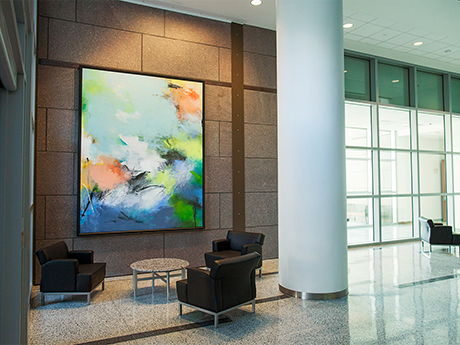By Fernanda Ogazon, president and CEO, American Art Resources
Incorporating art into commercial real estate is more than just decoration. It’s a strategic investment in tenant wellness, satisfaction and overall asset performance.
Evidence-based design (EBD) plays a crucial role in effectively integrating art into spaces, especially in environments like healthcare, hospitality and corporate offices. By relying on credible research, EBD helps ensure that the art chosen contributes to the stakeholders’ specific goals.

What It Means
According to the Center for Health Design, EBD is the process of basing decisions about the built environment on reliable research to achieve the best possible outcomes. In healthcare spaces, the right artwork can provide comfort, reduce stress and anxiety and support healing.
For example, patients in intensive care units may suffer from a condition that researchers have termed “ICU Syndrome,” which is characterized by hallucinations, delusions, psychotic episodes and sleep disturbances that have no direct link to the illness itself. Art for ICU patient rooms must therefore be very clear and completely unambiguous so as not to aggravate these symptoms.
Nature photographs with sunlight and full-spectrum color are successful choices for these settings because they are reality-based. The role of art in non-patient areas — family waiting areas, consult rooms, grief rooms — should be to offer comfort and to reduce the stress levels of family members. In these spaces, it is crucial to avoid images of sunsets, empty benches, single flowers in a vase or any images that evoke senses of death and loss.
How It Started
American Art Resources is a Houston-based, turnkey art consulting firm that has championed the use of EBD for more than 45 years. The company has delivered EBD solutions for over 20,000 projects across 300 million square feet globally.
In Texas, American Art Resources has incorporated EBD into several notable projects, including the Hyatt Place Houston Galleria, MD Anderson’s Zayed Building for Personalized Cancer Care, Texas Christian University’s Anne Burnett Marion School of Medicine and Memorial Hermann The Woodlands Medical Center. The artwork reflects the medical mission of each building in the following ways:
• Curated with top-tier visuals, each piece at the Hyatt Place Houston Galleria was selected to enhance the hotel’s refined atmosphere, creating a seamless blend of art and hospitality that is imbued with a sense of luxury, sophistication and timeless elegance.
• The collection at the Zayed Building for Personalized Cancer Care reflects MD Anderson’s commitment to compassionate care and holistic healing, offering moments of comfort, calm and connection.
• The mosaic Texas Christian University’s Anne Burnett Marion School of Medicine pays tribute to the university’s rich history and spirit, inspired by the Frog Fountain. The intricate artwork symbolizes growth, knowledge and the ripple effect of leadership.
• The art curated for the Memorial Hermann The Woodlands Medical Center promotes emotional well-being and reduces stress. Inspired by the natural beauty of The Woodlands, the artwork reflects surrounding landscapes that bring a sense of connection, calm and familiarity to patients, families and staff.
While the practice of using EBD is more common in healthcare spaces, it is expanding into the office, retail and hospitality sectors as benefits like improved tenant wellness and higher property values become clearer.
Tenant Well-Being
By applying the EBD model, property owners can select and integrate art in ways that maximize impact.
Studies have shown that curated art can reduce stress, enhance mood and boost productivity among tenants. According to a study from the University of Exeter, workers in an environment decorated with art and plants were up to 32 percent more productive than those who were not. In addition, the study found that those who worked in art- and plant-rich settings experienced 45 percent more well-being and 60 percent more engagement than those in a functional workspaces that are undecorated.
The strategic use of art in commercial environments can also go hand-in-hand with creative placemaking. This is the process of intentionally shaping the character and atmosphere of a space through the integration of art, culture and community-driven experiences. When paired with EBD, creative placemaking ensures that every artistic element reflects the values, identity and needs of those who use the space.
Whether it is a locally inspired mural in a lobby, a sculpture by a regional artist in a plaza or a rotating gallery featuring community artwork, these elements foster a sense of belonging and connection.
Boosting Property Values
Art not only enriches the tenant experience, but also elevates the perceived and real value of a property. Properties featuring well-executed art installations often command higher rents and premium sales prices, as they reflect a level of thoughtfulness and quality that distinguishes them in a competitive market.
Moreover, high-quality, curated art can make an environment feel more luxurious without investment in costly renovations or upgrades. For example, a bespoke mural in a lobby or an immersive lighting feature in a common area can signal intentional design and elevate the overall ambiance of a building. In particular, public art features have the unique ability to drive publicity and engagement from tenants, visitors or community members, thereby creating a sense that the property is a must-see attraction.
In today’s competitive commercial real estate market, integrating art is a strategic necessity. When guided by EBD and aligned with the principles of creative placemaking, art can support tenant well-being, foster deeper community connections and elevate the value of a property.


